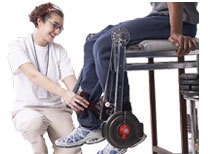|
|
|
Jarrod Shapiro, DPM
Practice Perfect Editor
Assistant Professor,
Dept. of Podiatric Medicine,
Surgery & Biomechanics
College of Podiatric Medicine
Western University of
Health Sciences,
St. Pomona, CA |
One of the "benefits" of having a child that dances is spending a cumulative several hours per week sitting and waiting for him to finish his classes and practice. Often, while I'm oh so patiently waiting, I see the teachers working on stretching with the dancers. We all know that for a dancer the ability to stretch their limbs beyond that of the average person is the most basic skill necessary for success. And with this most basic skill comes the pain associated with achieving it. I see and hear young dancers groaning with the discomfort of the stretch, while their teachers gently but firmly help them move further each time. It clearly is not a comfortable experience.  Yet these dancers willingly accept the pain in order to be able to do more advanced artistic movements that are impossible without stretching. Sitting here watching my son do the same thing makes me think about the necessity of pain in most things in life. Yet these dancers willingly accept the pain in order to be able to do more advanced artistic movements that are impossible without stretching. Sitting here watching my son do the same thing makes me think about the necessity of pain in most things in life.
The first time I heard the phrase "The Gift of Pain" was when Dean Harkless quoted from a legendary physician in wound care, Paul Brand, MD. Dr. Brand – sadly deceased now – described pain as a gift, protecting us from the ravages of the world around us. He was referring directly to diabetic neuropathic patients who lose this "gift" when they lose protective sensation. A patient with intact sensation will experience pain when they go beyond the tissue's capacity to sustain outside forces, while an insensate patient will continue to walk, moving beyond the tissue's ability to remain intact with the subsequent blistering, skin breakdown, and ulceration.
Similarly, most of us have this gift. The question, though, is what to do with it? Stretching doesn't come easily for my son. Unlike his female colleagues who seem to come premade with extra pliability, my son has inherited my stiffness of body. As a result he has to work extra hard to reach the same goals. And, of course, as an eight year-old he fights tooth and nail having to work hard, not understanding that he has to endure the pain to reach greater levels of success. Occasionally, though, he gets a glimpse of what his hard work and pain have purchased - the ability to dance gracefully.
If you think about it for a moment you might realize that everything worthwhile is bought at the cost of that same pain. For those of you with some type of advanced degree, think of how much work it took to accomplish your degree. You experience some type of pain – deferring your success, studying for long hours, challenging rotations, research, publishing, etc. – before finally obtaining your degree.
The same is true when working with our patients. They come to us in physical pain – the most common reason for physician visits – and we do our best to alleviate their pain. In some circumstances we need to cause them further pain, for example the pain of surgery or that of physical therapy, to benefit them in the long run.
Think also of the most fundamental pain: giving birth. Women experience significant pain to birth a child with the obvious subsequent benefits of family and passing on one's genes and family name to the next generations. I would definitely argue family has its moments of pain!
What would have happened if you were adverse to life's pain? You likely would have failed. I commonly see the results of this in the first year classes at my college. Most of the students have recently completed their bachelor's degree. For many of them college was relatively easy at least compared with podiatric medical school. Some of them don't realize for the first few weeks that podiatric medical school is extremely difficult; requiring dedication, hard work, focus, and completion of challenging exams. In short, pain. The students who learn this quickly do well while the others flounder. The students who continue to fight this pain eventually fail.
So, what do we do with the knowledge that pain is an integral and important part of life? This has an easy two part answer. First, accept that pain is necessary to accomplish anything worthwhile. This might be a warning to us to be cautious of anything that comes too easy. Second, get used to the pain. This is perhaps the harder of the two ideas. Relax into the pain, let it wash over and become part of you. While stretching, it is counterproductive to tighten the muscles and fight the stretch. Instead, one must relax the muscles, let the pain come, and then allow it to pass. We must do the same with life. Embrace the pain of that new activity; relax into it, so you can look forward to future success.
Best wishes.

Jarrod Shapiro, DPM
PRESENT Practice Perfect Editor
[email protected]
Get a steady stream of all the NEW PRESENT Podiatry
eLearning by becoming our Facebook Fan.
Effective eLearning and a Colleague Network await you. |
 |
This ezine was made possible through the support of our sponsors: |
|